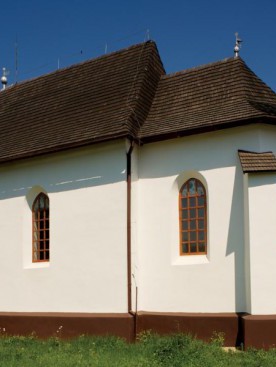The Calvinist Church –AkliAkli is situated on the territory of the historical Ugocsa county and was mentioned for the first time, rather late, in sources stemming from the first half of the 14th century. The congregation in Akli had been for a long time a filia subordinated to the Halmi parish, and became a separate congregation only in 1474. This small, oriented church has preserved its medieval shape. The nave having a rectangular base is connected to a sanctuary enclosed by five sides of an octagon and covered by a single-cell vault. No buttresses fortify the corners of the nave, and its western frontispiece is divided in two parts by a portal. An ogee arch spans the latter. The southern side is divided by two windows spanned by archivolts and decorated with traceries. No architectural elements divide the northern wall. The chancel arch is a lancet arch. The entrance to the sacristy is on the northern side of the sanctuary and is encased by a stone frame, the lintel being supported by a canopy on each side. East to the gate there is a bay enclosed by an irregular form, its opening being spanned by an ogee arch. On the eastern end of the southern side there is a sedilia encased by a unitary frame and spanned by a segmental arch. The present barrel vault ceiling of the sacristy might as well stem from the Middle Ages. On the basis of preserved shape details, one might suspect that the entire church was built during a single period: most probably around 1500, or in the first 25, maybe roughly 35 years of the 16th century. A similar church to the one in Akli is located in Csepe. The entire form and outlook of these two places of worship bear resemblances; moreover, their western gates are identical and their tracery decorations almost identical. The previous filia in Akli, subordinated to the Halmi parish and mentioned in 1474, must have been a different church, not the one standing today. The construction of the latter was financed by the Magyi family, who acquired full possession of the village not later than 1471, and owned it at least until the mid-16th century. The family descended probably form the Gutkeled clan as the shield in the sanctuary seems to bear the symbols painted on the clan’s coat of arms. |
















